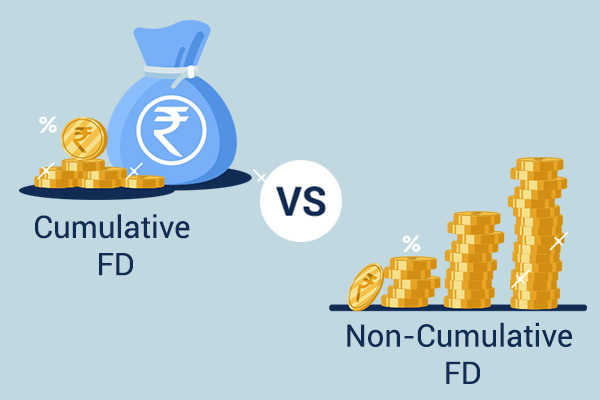Difference Between Cumulative and Non-Cumulative FD

Before discussing the cumulative and non-cumulative fixed deposits, the basic idea of the fixed deposit should be highlighted. Fixed deposits are widely popular among Indians because of their certainty of return rate. Fixed deposits are generally of two types: cumulative and non-cumulative.
The basic definition of cumulative FD is that its interest rate is accumulated and given at maturity. In contrast, non-cumulative FD releases the interest rate monthly, quarterly, and yearly. Investors often get these two types of FD while trying to open their new accounts.
Cumulative Fixed Deposit vs Non-Cumulative Fixed Deposit
Particulars |
Cumulative FD |
Non-Cumulative FD |
Definition |
Interest is accumulated through the entire FD tenure |
Interest is not accumulated |
Interest Payout |
Paid on maturity |
Paid on a monthly, quarterly, half-yearly, or yearly basis |
Income Flow |
No income during the FD tenure |
Regular income flow throughout the tenure |
Reinvestment |
Yes |
No |
Depositor earns interest on interest |
Since the interest in paid out, there is no reinvestment option here |
|
This leads to higher interest than non-cumulative FD |
Total interest is slightly lesser than the cumulative option |
|
Suitable for |
Salaried people or those with stable profits |
Retirees, housewives, and freelancers |
Indians are rooted in a secure environment when it comes to investment. Hence, the fixed deposit investment option is widely popular. Investment in a fixed deposit is mainly viewed as a safe and secure choice as the return amount is guaranteed. There is a specific lock-in time ranging from 6 months to 10 years. Now, the investors have the choice on their sleeves which fixed deposit option they will choose. In RBL Bank, the fixed deposits below 181 days will be counted as the simple interest rate.
The prime banks and NBFCs offer two basic types of fixed deposits. Investors need to choose the fixed deposit type based on their needs. Few want to get the interest as regular payouts for expanding their business, while others want to secure the money for a specific time to multiply the amount. This is how the cumulative and non-cumulative fixed deposit types come to the surface.
Let us look at the advantages and disadvantages of cumulative and non-cumulative fixed deposits to help you make a well-informed investment decision.
Pros and Cons of Cumulative & Non Cumulative FD
A cumulative fixed deposit interest rate is reinvested. This fixed deposit option is better known as multiplying the income. Investors for their long-term projects often put the money for a lock-in period. In such cases, cumulative fixed deposits work in sync with the purpose, especially for long-haul projects.
Investors who are looking for a short-term investment should choose a non-cumulative fixed deposit. An interest payment is added to the daily payout of a non-cumulative fixed deposit. This fixed deposit is a good-to-go option for the short-term business-oriented investors. Small businesses get colossal profit from this type of investment. This fixed deposit option is also an ideal option for the pensioner.
There is an advantage in receiving interest every month. But in the cumulative FD, one would not get access if they have selected the lock-in period over three years. The cumulative fixed deposits and their interest rate can be reinvested after maturity. As it starts from 6 months, one can choose the monthly or yearly period depending upon their choice.
Cumulative fixed deposit brings add-ons to the saved amount. The return rates are not fixed in this fixed deposit. It can vary from half-yearly or every year. Due to its regular payment scheme, the Interest rate gets lower than the non-cumulative FD. For example, investors can receive an interest rate of 6.85% to 7.00%. The investors can select the tenure at their disposal. In this type of fixed deposit, there is no chance of reinvestment.
Which one is profitable: cumulative or non-cumulative?
These two fixed deposit types are profitable depending upon the investor’s choice. A cumulative fixed deposit is worthwhile, and the return rate is slightly higher than the non-cumulative. But this fixed deposit is locked in for a specific timeframe. Non-cumulative provides interest payout regularly. This is the best option for those who need money regularly. People who live on a pension after retirement can opt for such a fixed deposit. This type of FD has no option for reinvestment but provides the best return rate. Let’s check the example below to find out more about the profitability of cumulative or non-cumulative.
Example:
If an investor opens a fixed deposit in a bank with Rs. 1 Lakh for 5 years and the interest rate is 6% per annum.
For a non-cumulative FD, the interest payout will be as follows:
Year |
Investment |
Interest |
Final Amount |
1 |
100000 |
6937.2 |
106937.2 |
2 |
100000 |
6937.2 |
106937.2 |
3 |
100000 |
6937.2 |
106937.2 |
4 |
100000 |
6937.2 |
106937.2 |
5 |
100000 |
6937.2 |
106937.2 |
For a cumulative FD, the interest payout will be as follows:
Year |
Investment |
Interest |
Final Amount |
1 |
100000 |
6937.2 |
106937 |
2 |
106937 |
7191.25 |
114128 |
3 |
114128 |
7442 |
121570 |
4 |
121570 |
7689 |
129259 |
5 |
129259 |
7932 |
137191 |
So, it would be wise for investors to map out their monetary needs and invest accordingly. It will give them considerable benefits on their invested capital. RBL Bank has tailor-made its page for investors to know more details about fixed deposits.

 Blog
Blog Blog
Blog



Comments
No comments yet.